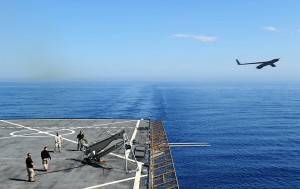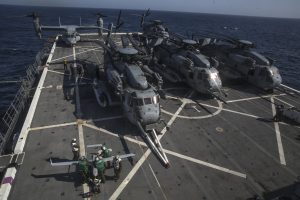2017-05-26 By Robbin Laird
The USMC is changing significantly as it shifts from the land wars to its evolving role as the nation’s key full spectrum insertion force.
An entire generation of Marines has fought ashore and become a flexible land force; with the drawdown in the land wars in the Middle East, the Marines have returned to the sea and are for a new generation learning how to operate from the sea base.
But under the twin impact of the Osprey and the F-35B this is unlike any Navy-Marine Corps team to operate from the sea.
The Marines can operate at distance and with greater lethality from the sea.
And also, crucial to the reworking of the Navy-Marine corps team operating from the sea has been the evolution of the amphibious task force itself.
The classic ARG-MEU operating within a 200-mile operational box dictated by the rotorcraft onboard has changed dramatically as the Osprey has liberated the ships to operate at much greater distance from one another.
A new generation operational capability of the disaggregated force able to operate from the amphibious task force has emerged.
The amphibious task force is a work in progress as new capabilities are added to the force, such as the CH-53K, the new heavy lift element and unmanned systems.
The Blackjack at Sea from SldInfo.com on Vimeo.
These systems are being incorporated into the most flexible and lethal insertion force built in history.
For the Marines, unmanned systems have been utilized significantly during their participation in the land wars.
The Marines have operated the Shadow unmanned systems along with the Army in the Middle East; this UAV requires land basing and as such goes against the grain of the return to the sea and the evolution of the amphibious task force.
It is their other unmanned system – namely the ScanEagle, whose origin was at sea – that has formed to core experience being taken to sea.
And along with it the next round of unmanned development for the Marines, namely the Blackjack or as it is known in its commercial variant, the Integrator.
To understand the role of these systems within the overall evolution of the Marine Corps, I had a chance to talk with Art Crowe, a former Marine, now working with Insitu, the company responsible both for ScanEagle and Blackjack.
 Civilian contractors from Insitu Inc., launch a Scan Eagle unmanned aerial vehicle from the flight deck of the amphibious dock-landing ship USS Gunston Hall (LSD 44). Credit: Navy Media Content Services, 4/28/12
Civilian contractors from Insitu Inc., launch a Scan Eagle unmanned aerial vehicle from the flight deck of the amphibious dock-landing ship USS Gunston Hall (LSD 44). Credit: Navy Media Content Services, 4/28/12
Art Crowe is a former Harrier pilot who was the Operations officer of VMU-2 in 2003-2004.
He participated in the first battle of Fallujah and his combat experience clearly guides his thinking on how remotes can provide a combat edge for Marines as they build out their amphibious capabilities.
UAS’ for the Marines are to be understood in the context of the overall evolution of the amphibious task force and the flexibility the commander of the force will be looking for.
He may operate the UAS from the ship to assist Marines inserting force for a short duration mission.
He may take that UAS from the ship and operate it ashore with deployed Marines.
It is the flexibility of the overwatch asset and evolving payload flexibility of the UAS that will be important to that commander going forward.
But this is a work in progress, much like the core system being deployed, the Blackjack is a work in progress.
Question: What was the origin of the coming of ScanEagle to the Marine Corps?
Crowe: General Conway, later Commandant of the USMC, was in Iraq in 2004 and was looking for support for his maneuver force.
He wanted a way to get support from an effective UAS without having to wait for a long acquisition process.
He got that through a services contract with Insitu whereby the company provided ISR services but operated the assets.
The Marines provided security and operational support; the company operated the asset and delivered the product to the Marines.
Question: This was the origin then of a company operated and company owned system. What was the advantage to both company and the Corps of such an approach?
Crowe: The company could evolve the capabilities of ScanEagle in concert with the feedback from their UAS Operators and Marines on their operational needs.
Rather than going through a long requirements generation process, the company could evolve the capabilities of the aircraft and the payloads to provide for the services the Marines required.
This allowed for rapid innovation and adaptation to customer needs.
The payloads then evolved over time to provide data to meet the evolving needs of the USMC, with the service contract delivering the payoff for the company.
ScanEagle’s latest generation of infrared/electro-optical sensors is the 900 series of turrets.
https://insitu.com/information-delivery/unmanned-systems/scaneagle/imagers#2
And this evolution of capability has been driven by the company in interaction with the USMC, the US Navy and other DoD and foreign customers.
ScanEagle has become a product and capability deployed worldwide.
The genesis of ScanEagle was in fact to support weather reconnaissance and commercial fishing fleets, so it has been a maritime-proven platform from the beginning.
The return to the sea for the Marines has provided a venue within which ScanEagle has returned home so to speak.
Question: One of the other deployed UAS from Insitu is the RQ-21A Blackjack.
How was this procured and how is it being used?
Crowe: The Navy and Marines procured The Blackjack through the traditional procurement model.
The Navy approved acquisition in 2010 and operated the first Early Operational Capability (EOC) Blackjacks in 2014.
The Program achieved Initial Operational Capability in 2016.
 PACIFIC OCEAN, Calif., — Marine Medium Tiltrotor Squadron 161 (Reinforced) attached to the 15th Marine Expeditionary Unit load the flight deck of the USS San Diego (LPD-22) with several air assets, April 11, 2017. The 15th MEU uses the air assets provided from VMM-161 to transport personnel and equipment from ship-to-ship and ship-to-shore efficiently. The 15th MEU’s rapid ability to mobilize people and equipment makes the amphibious force uniquely postured to respond to any mission around the globe. (U.S. Marine Corps photo by Cpl. Timothy Valero)
PACIFIC OCEAN, Calif., — Marine Medium Tiltrotor Squadron 161 (Reinforced) attached to the 15th Marine Expeditionary Unit load the flight deck of the USS San Diego (LPD-22) with several air assets, April 11, 2017. The 15th MEU uses the air assets provided from VMM-161 to transport personnel and equipment from ship-to-ship and ship-to-shore efficiently. The 15th MEU’s rapid ability to mobilize people and equipment makes the amphibious force uniquely postured to respond to any mission around the globe. (U.S. Marine Corps photo by Cpl. Timothy Valero)
The Blackjack is different from ScanEagle.
While it operates with similar launch and recovery equipment, it is larger and designed to be an air vehicle that can operate a variety of payloads.
The aircraft is built around a center of gravity payload bay.
It is a modular set up where you can configure a variety of payloads.
There is room on the air vehicle for up to 39 pounds of payloads, which operate with up to 500 watts of power.
As long as you can meet those requirements and operate with the interface control, you can integrate various payloads.
The Marines have operated ashore and have now brought it to the amphibious force.
Blackjack is configured to operate off of San Antonio class L ships. It first deployed last year with the 22nd MEU and is currently operating with deployed forces.
Operating a UAS off of a ship can be more challenging than ashore.
Integrating the air platform within the workflow of the ship is one challenge; operating with the different operational impacts of the air fleet is another.
And working the launch and recovery can be more challenging in a dynamic shipboard environment. This continues to be a focus of effort for the Blackjack team.
Question: The sun setting of the Prowler has set the stage for another key development for the Blackjack, namely providing support for the MAGTF along with the F-35 for electronic warfare.
How do you see this challenge?
Crowe: The sun setting of the Prowler in 2019 is a key driver of needed capability.
The payload flexibility of the Blackjack means that it could be part of the EW capability for deployed Marines and because we are working the shipboard integration it could be part of that package as well for the at sea force.
It is a work in progress but a key part of the way ahead for the Marines and Blackjack.
Editor’s Note: With regard to the Scan Eagle and its coming to the Marines in Iraq and Afghanistan, then head of 2nd MAW, General “Dog” Davis, underscored that combining UAVs with Harriers at FOB Dwyer created a powerful combat capability:
From the time they left station and the time they were back overhead in about 30, 35 minutes.
That kind of performance and capability is unique for a TACAIR platform.
By investing up front in FOB Dwyer, we could take 10 STOVL attack aircraft and make 10 airplanes perform like 40 anywhere else.
FOB Dwyer was more than just a Harrier strip.
It was a combat strip.
We based some of our VMUs down there flying both Scan Eagle and Shadow UAVs.
We initially sized the length of Dwyer based on what it took us to get a fully loaded C130 with a full bag of gas and full logistics load in there.
And on a hot day, and at the filed elevations we are dealing with in that part of Afghanistan that comes out to about a 4,000 foot strip.
The template for the Marine Corps in the future should allow us to operate at full capability wherever we can put 4,000 foot strip.
We published a four part video series in 2013, which shoed the Scan Eagle from preparation to flight, to flight, and return as well as operators comments about the use of the Scan Eagle in Afghanistan.

